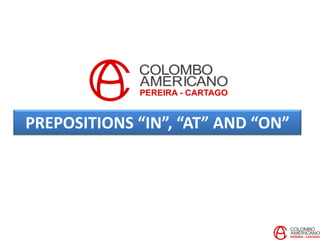Course 2-Unit 5: Verb to be - prepositions in, at and on
•
1 gefällt mir•6,234 views
This document discusses the use of the prepositions "in", "at", and "on" with dates and times. It provides examples showing that "at" is used to specify the time something occurs, "on" is used to specify the day or date, and "in" is used to specify the month. It concludes by summarizing these uses in a chart for quick reference.
Melden
Teilen
Melden
Teilen

Empfohlen
Weitere ähnliche Inhalte
Andere mochten auch
Andere mochten auch (20)
Course 6-Unit 7: Regular and irregular verbs. spelling -

Course 6-Unit 7: Regular and irregular verbs. spelling -
Digital Media as Communications Tool for ECHODigital2011

Digital Media as Communications Tool for ECHODigital2011
Course 9-Unit 4: Direct object placement with phrasal verbs.

Course 9-Unit 4: Direct object placement with phrasal verbs.
Creating Digital Exhibits for Critical Inquiry of Media Representations

Creating Digital Exhibits for Critical Inquiry of Media Representations
Course 5 - Unit 14: Be going to + base form for plans.

Course 5 - Unit 14: Be going to + base form for plans.
Use of Apps to Engage Students in Collaborative Writing, Great Plains Composi...

Use of Apps to Engage Students in Collaborative Writing, Great Plains Composi...
2009top10smallbusinesstrends 090528112514 Phpapp02

2009top10smallbusinesstrends 090528112514 Phpapp02
Mehr von Martin Caicedo
Mehr von Martin Caicedo (20)
Course 12-Unit 2: Perfect modals meaning and form. check for must, will be ab...

Course 12-Unit 2: Perfect modals meaning and form. check for must, will be ab...
Course 10-Unit 7: Gerunds as objects of prepositions.pending for review

Course 10-Unit 7: Gerunds as objects of prepositions.pending for review
Course 9-Unit 6: To make an offer or a suggestions with why don't ...

Course 9-Unit 6: To make an offer or a suggestions with why don't ...
Course 9-Unit 5: Quantifiers for indefinite quantities and amounts.

Course 9-Unit 5: Quantifiers for indefinite quantities and amounts.
Course 8-Unit 3: Perfect modals meaning and form. adjust.

Course 8-Unit 3: Perfect modals meaning and form. adjust.
Course 8-Unit 2: The use of would rather + base form of verb.

Course 8-Unit 2: The use of would rather + base form of verb.
Course 9-Unit 6: To make an offer or a suggestions with why don't.

Course 9-Unit 6: To make an offer or a suggestions with why don't.
Course 9-Unit 5: Quantifiers for indefinite quantities and amounts.

Course 9-Unit 5: Quantifiers for indefinite quantities and amounts.
Course 9-Unit 4: Direct object placement with phrasal verbs.

Course 9-Unit 4: Direct object placement with phrasal verbs.
Course 8-Unit 3: Perfect modals meaning and form. adjust.

Course 8-Unit 3: Perfect modals meaning and form. adjust.
Course 2-Unit 5: Verb to be - prepositions in, at and on
- 1. PREPOSITIONS “IN”, “AT” AND “ON”
- 2. PREPOSITIONS “IN”, “AT” AND “ON” When is the game? The game is at 1:00 p.m. The game is on Wednesday. The game is on January 2nd The game is in January.
- 3. PREPOSITIONS “IN”, “AT” AND “ON” When is the concert? The concert is at 8:30 p.m. The concert is on Sunday. The concert is on August 21st The concert is in August.
- 4. PREPOSITIONS “IN”, “AT” AND “ON” When is the party? The party is at 6:00 p.m. The party is on Tuesday. The party is on April 21st The party is in April.
- 5. PREPOSITIONS “IN”, “AT” AND “ON” When is the game? The game is at 6:30 p.m. The game is on Thursday. The game is on December 6th The game is in December.
- 6. PREPOSITIONS “IN”, “AT” AND “ON” When is the game? To say the complete date (para decir la fecha completa) on on To say the day only (para decir solo el día) at To say the time only (para decir solo la hora) To say the month only (para decir solo el mes) in
- 7. Thank you!!
